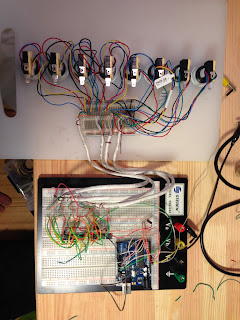Example code is all done, and with some tweakin' she works!
Thursday, November 28, 2013
Lumithesia Project - Overview
Okay, this has been a long time coming, but over the past few months, I've been working on a project, I call, Lumithesia.
Essentially, it's a giant 8' x 8' interactive dance floor that can detect users moving above it and react with swirling colors encircling the dancer that which are synched with the music.
Some highlights:
Essentially, it's a giant 8' x 8' interactive dance floor that can detect users moving above it and react with swirling colors encircling the dancer that which are synched with the music.
Some highlights:
- 32x32 = 1024 pixels. Each pixel has the following:
- An IR LED
- An IR phototransistor
- A WS2801-based addressable RGB LED
- Entire floor is made of 4, 4'x4' units. Each unit has:
- An Arduino Due which:
- Performs 1-million Analog-to-digital conversions a second for the IR pairs
- Streams data to the RGB pixels
- The whole enchilada is controlled by a UDOO Quad which is responsible for:
- 2.2Mb/sec out, and 1.0Mb/sec in via USB to the 4 Arduino Dues
- Parsing the incoming IR data, applying filters via the music and outputting data at 120fps
Structurally, it will be made of translucent 1/2" acrylic with aluminum supports, and a grid of acrylic rods.
Needless to say, it's a huge undertaking. But, it did motivate me to acquire and obscenely upgrade my CNC (posts to come).
Here's what the pixel units will look like (I decided to use acrylic because it's cheap and pretty):
Wednesday, November 27, 2013
Synchra Project - RGB 7-Segment LEDs
Behold...
Yes, an individually addressable 7-segment RGB LED (geek drool). Well, I couldn't help myself from grabbing a couple of these from Adafruit:
Adafruit's RGB 7-Segment LED
Here's a couple things I was surprised about.
Yes, an individually addressable 7-segment RGB LED (geek drool). Well, I couldn't help myself from grabbing a couple of these from Adafruit:
Adafruit's RGB 7-Segment LED
Here's a couple things I was surprised about.
- These things are big. I guess I should of figured from the description, but certainly much larger than anticipated. 0.947" wide by 1.403" tall, although the segment portion itself is 1" tall, as advertised.
- The decimal point isn't connected, kinda a bummer.
- A whole mess of connections on the back. Again, something that should of been obvious, it's seven RGB LEDs after all. So, the 25 pins on the back shouldn't of surprised me, although three are not connected.
So, when I got them, I wanted a way to mount them. Yes, I know that, typically speaking, people solder them onto a PCB and then mount that. But, this thing doesn't play well with standard, columned breadboards. So, I decided to make a lil' mount for them with my CNC and then wire-wrapped a heap of wires to the pins...
Also, I improved on the schematic to help clear up what goes where:
Misc Project - Cross Holder
I just got back from a lovely wedding in Maui, my friends needed a holder for a sentimental cross they have, so from a couple photos, I whipped this up in Solidworks:
Soon after, my friend and I were discussing a better design that would actually have the two pieces click together forming a stronger base. Here are the two pieces rendered from Solidworks..
So, I threw it on my CNC, got some 1/8" cast acrylic, and cut it out...
Soon after, my friend and I were discussing a better design that would actually have the two pieces click together forming a stronger base. Here are the two pieces rendered from Solidworks..
Synchra Project - Lots of RGB LED Arcade Buttons
A test of eight RGB LED Buttons.
It's driven with two TLC5941s, 16-Channel PWM LED sink ICs and a Arduino Uno. I have to say I love these chips:
- 4,096 levels of PWM
- 16-Channels per chip (5 RGB LEDs)
- Only one resistor for all 16 channels
Digikey: http://www.digikey.com/product-detail/en/TLC5941NTG4/TLC5941NTG4-ND/2047723
Here's the guts of it:
RGB Arcade Button
Well, hello world! I just got done with a lovely Instructable on converting a square arcade button to an RGB Arcade button for my new "Syncra" project
Subscribe to:
Comments (Atom)




















